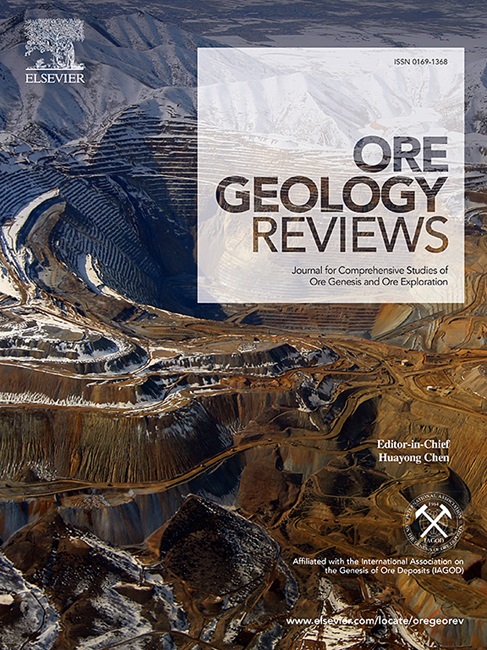Geochemical constraints on the genesis of Au mineralization at the Wangzhuang deposit, South Qinling, China: Insights from fluid inclusion, trace elements, and H–O–S–Fe–Pb isotopic studies
IF 3.6
2区 地球科学
Q1 GEOLOGY
引用次数: 0
Abstract
The Zhen’an–Xunyang Basin, a rifted basin in the South Qinling orogenic belt, hosts significant Hg–Sb–Au deposits, including Gongguan, Qingtonggou, and recently discovered Carlin-type gold deposits like the Wang Zhuang deposit. The Wang Zhuang gold deposit, characterized by bedding-parallel fault zone control, providing the setting to study the genetic mechanisms of Au deposits. Current assessments indicate a potential Au resource of 2.57 tons within the Wangzhuang gold deposit, highlighting promising prospects. The alteration and mineralization processes of the Wangzhuang deposit are divided into three stages: (Ⅰ) arsenopyrite–quartz vein stage, (Ⅱ) quartz veins with arsenian pyrite stage, and (Ⅲ) quartz-carbonate stage. The initial two stages, reflecting the principal phase of ore formation, are closely interconnected, while Stage III encompasses a subsequent phase of mineralization characterized by relatively weaker alteration and mineralization. This study reveals magmatic involvement in ore formation through H–O–S–Fe–Pb isotope analyses. Fluid inclusion analyses of quartz reveal that the Au mineralization is associated with medium– to low–temperature (112–330 °C) and medium– to low–salinity (1.3–11.4 wt% NaCl equivalent) fluids enriched with organic components. The H–O isotopes of quartz show δDV-SMOW values ranging from −83.8 ‰ to −75.4 ‰, decreasing from early to late mineralization stages. S isotopic analyses of pyrite and arsenopyrite reveal δ34S values of 8.4 ‰ to 10.9 ‰ in arsenopyrite, significantly lower than the δ34S values of 35.6 ‰ to 60.4 ‰ in the surrounding strata, indicating a non-stratigraphic sulfur source. Fe isotopes suggest that δ56Fe values range from 0.2 ‰ to 2.1 ‰ before mineralization and 0.6 ‰ to 2.0 ‰ during mineralization, indicating Fe was primarily derived from adjacent strata. Pb isotopic ratios of pyrite and arsenopyrite exhibit the following ranges: 208Pb/204Pb from 39.700 to 40.368, 207Pb/204Pb from 15.977 to 16.073, and 206Pb/204Pb from 18.543 to 18.811. When integrated with Pb isotopic data from the Jinlongshan and Gongguan deposits in the same region, the isotopic evolution trend aligns with that of Late Jurassic granites, indicating that Pb originated from a mixture of magmatic and stratigraphic sources. In summary, magmatic fluids mobilized metals from Cambrian strata, serving as the primary ore-forming source. Fluid mixing and changes in physical and chemical conditions likely facilitated gold precipitation. The Au–Hg–Sb deposits in this region may share a common ore-forming process, with host rock characteristics and the distinct properties of Au, Hg, and Sb determining their segregation.

南秦岭王庄金矿成矿成因的地球化学约束:流体包裹体、微量元素和H-O-S-Fe-Pb同位素研究的启示
镇安—旬阳盆地是南秦岭造山带的断陷盆地,具有重要的铜关、青铜沟等金银金矿床,最近又发现了王庄等卡林型金矿床。王庄金矿床受层理-平行断裂带控制,为研究金矿床的成因机制提供了背景。目前评价表明,王庄金矿床潜在金资源量为2.57吨,远景广阔。王庄矿床蚀变成矿过程分为3个阶段:(Ⅰ)毒砂-石英脉阶段、(Ⅱ)含砷黄铁矿的石英脉阶段和(Ⅲ)石英-碳酸盐阶段。前两个阶段反映了成矿的主要阶段,相互联系紧密,而第三阶段则是成矿的后续阶段,其蚀变和成矿作用相对较弱。通过H-O-S-Fe-Pb同位素分析,揭示岩浆对成矿的参与作用。石英流体包裹体分析表明,金成矿与中低温(112 ~ 330℃)和中低盐度(1.3 ~ 11.4 wt% NaCl当量)富有机质流体有关。石英H-O同位素δDV-SMOW值在−83.8‰~−75.4‰之间,由成矿早期到成矿晚期呈递减趋势。黄铁矿和毒砂的S同位素分析表明,毒砂的δ34S值为8.4‰~ 10.9‰,明显低于周围地层的35.6‰~ 60.4‰,表明其为非地层硫源。成矿前δ56Fe值为0.2‰~ 2.1‰,成矿时δ56Fe值为0.6‰~ 2.0‰,表明成矿主要来源于邻近地层。黄铁矿和毒砂的Pb同位素比值分别为:208Pb/204Pb为39.700 ~ 40.368,207Pb/204Pb为15.977 ~ 16.073,206Pb/204Pb为18.543 ~ 18.811。结合同一地区金龙山和拱关矿床的Pb同位素资料,其同位素演化趋势与晚侏罗世花岗岩一致,表明Pb的成因是岩浆源和地层源的混合。岩浆流体调动了寒武系地层中的金属,是成矿的主要来源。流体混合和物理和化学条件的变化可能促进了金的沉淀。该地区金、汞、锑矿床可能具有共同的成矿过程,寄主岩石特征和金、汞、锑的不同性质决定了它们的分离。
本文章由计算机程序翻译,如有差异,请以英文原文为准。
求助全文
约1分钟内获得全文
求助全文
来源期刊

Ore Geology Reviews
地学-地质学
CiteScore
6.50
自引率
27.30%
发文量
546
审稿时长
22.9 weeks
期刊介绍:
Ore Geology Reviews aims to familiarize all earth scientists with recent advances in a number of interconnected disciplines related to the study of, and search for, ore deposits. The reviews range from brief to longer contributions, but the journal preferentially publishes manuscripts that fill the niche between the commonly shorter journal articles and the comprehensive book coverages, and thus has a special appeal to many authors and readers.
 求助内容:
求助内容: 应助结果提醒方式:
应助结果提醒方式:


